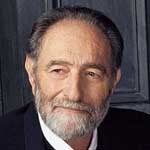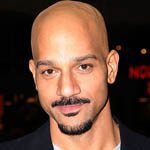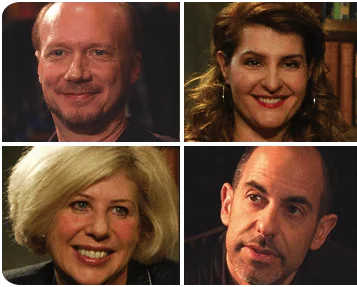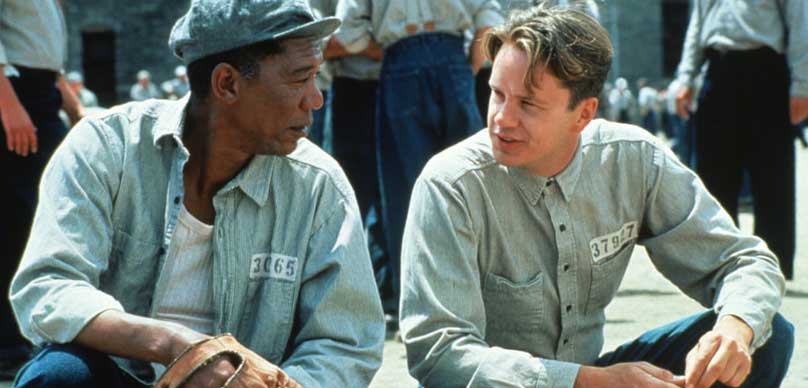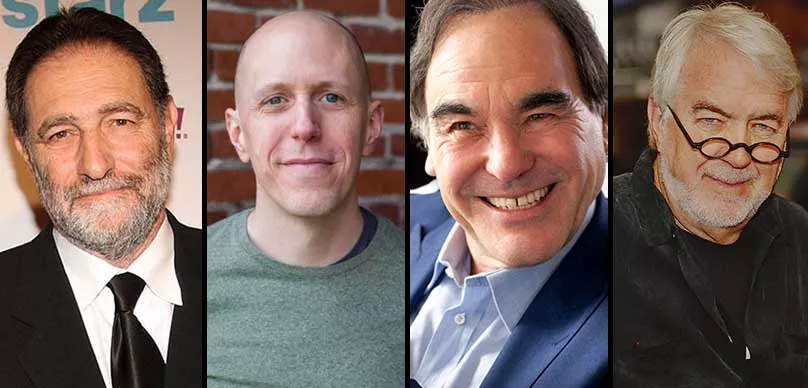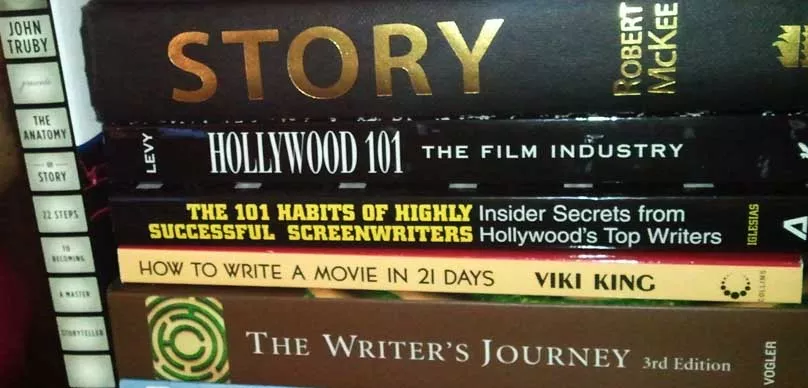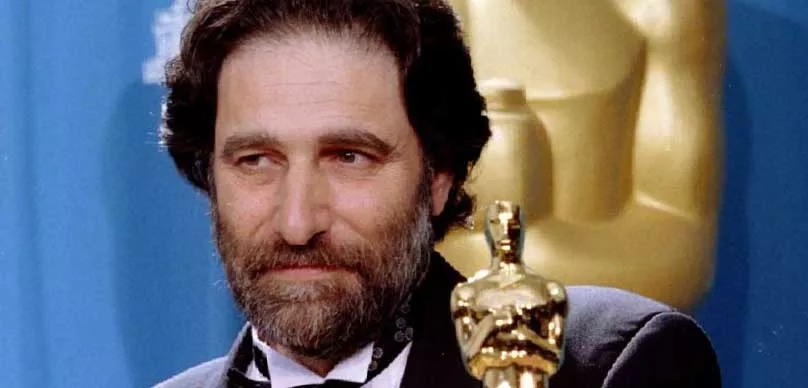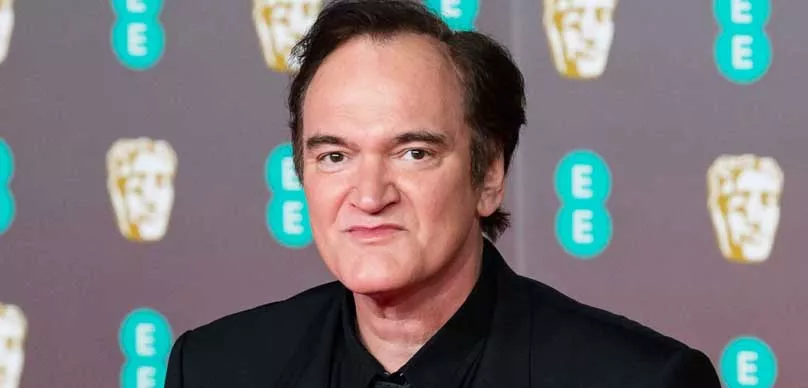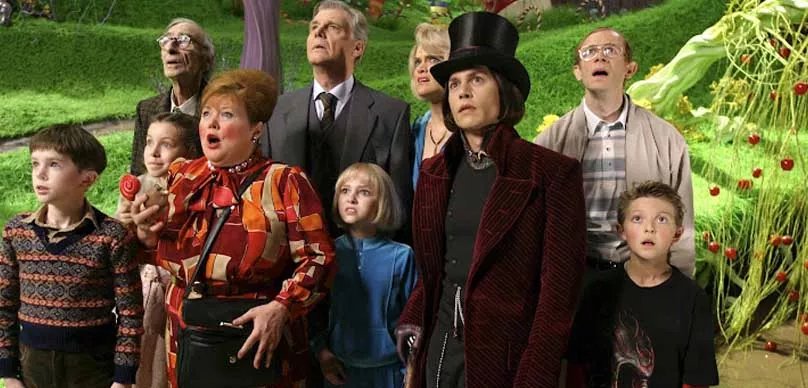Brendan McCarthy studied Painting and Film at Chelsea school of Art under the celebrated British Pop Artist Patrick Caulfield.
Brendan is one of the UK’s most gifted graphic novelists. His ground-breaking comics of the early 80s (Strange Days, Skin, Rogan Gosh) as part of ‘The British Invasion’ paved the way for comics’ increasing popularity in Hollywood.
He was also one of the pioneers of computer animation, creating the visuals for the 90s computer animated TV series ReBoot, the first long-form digital narrative that preceded Pixar and Dreamworks’ later successes. He has spent more than 20 years working in Hollywood, and is the co-writer and a designer on Mad Max Fury Road.
More recently, Brendan has created new graphic novels including Spider-Man Fever (for Marvel), Solo (for DC Comics) and Swimini Purpose, The Zaucer of Zilk and Dream Gang for independent US publishers. A best-selling retrospective collection of his classic comic book work was released last year, The Best of Milligan & McCarthy.
Enjoy your journey into the mind of Brendan McCarthy.
Alex Ferrari 0:05
Hey guys, so I wanted to let you know what we're going to be doing now on the show. Moving forward for a little while, I wanted to kind of bring in some amazing episodes from the indie film hustle podcast network with guest hosts. And you might recognize some of these guests hopes we'll have Dave Bullis, Jason Buff, and Scott McMahon guest hosting some of these episodes every week. Now we're going to be doing still our regular episodes on once a week. And then we're going to be doing these guests episodes, the second part of the week, and that way we can get you guys more amazing content, and help you move forward on your filmmaking or screenwriting journey. So sit back, relax. Enjoy today's episode with guest host, Jason buff.
Jason Buff 2:29
Hello, and welcome! I'm your host Jason Buff. We're talking with Mad Max Fury Road co writer, Brendan McCartney. I'm extremely excited about talking with Brendon. Mad Max Fury Road just blew my socks off. I can't believe that George Miller has gone back and made another Mad Max movie. For any of you that know the story about George Miller in the background of the Mad Max Movies. You got to be excited to know that this movie is out there now. I've seen it once. I can't wait to go see it again. But anyway, you know, so Brennan, and I talk a little bit about his background in comics. But then we get straight into talking about working with George Miller on Fury Road. So here we go. The first thing I was hoping we could talk about because most of our listeners are, you know, have a film background but don't necessarily have a comic background. So I was wondering if you could talk about your background in comics and kind of what got you into doing comics in the first place?
Brendan McCartney 3:28
Okay. Well, I read comics when I was a kid. I was I'm English and in the UK we used to get American comics imported into certain news agents. And I would pick off spinner racks, things like original things like the Steve Ditko Spider Man Ron Jack Kirby's fantastic for Ron, and some of the DC Comics, the Silver Age ones like the Infantino flash, deal, Gil kings, Green Lantern, and Adam. So that was my choice when I was raised on British comics, but gradually moved over to the American comics and shout out Pharmacol who were in the UK. And that led to a lifelong interest in the comic book medium and a desire to develop it turn into something akin to what music occupies in culture or uses, that we could grow this medium up and do substantial work in the comic book field. I always had that intention, I always felt it was possible to become if you like, the Beatles of comics, as opposed to, you know, to turn comics into something much more exciting socially. And I was part of the 80s. UK what's known as the British Invasion, which led by Alan Moore. People like Neil Gaiman. Later Grant Morrison, John Wagner writer Charles straight, was part of that original movement. And I worked with a writer called Peter Milligan who went on to become a big name writer in comics, and worked for about 15 years in Kent. Max before leaving to get into computer animation.
Jason Buff 5:04
Did you always did you start out doing things? subjects that were more kind of surreal or did you start out doing more like traditional comics.
Brendan McCartney 5:15
But when I was a young kid about 10, I was drawing learned superhero comics, the tumor was one of mine, you may never have heard of them. And worthy exactly, because it was drawn in the back of my school book. But as I went to art college and studied painting and surrealism and data is and all the opened and expanded my understanding of visual arts, storytelling, all sorts of stuff I did a painting and film degree so that a strong interest in film as well. So when I started to actually produce my material comics from from my new team zero then the aspirations had grown past superheroes. And I was interested in surrealism and the sort of, at the time when I came of age, punk rock was happening. So that infused by art with a with a ton of edgier graphic sensibility. Much of it inspired by a non comic artist called Design he did the Sex Pistols, posters, I just mean momentarily. He did all the famous Sex Pistols. Jamie something. Anyway, he was a big influence on me with that very hard edged, photocopied cut up style. And I took that kind of style. And just just at the same time in the marketplace, a rising up was it British comic, or 2000 ad, which featured Judge Dredd, which seemed to kind of everybody who ever became anybody in British comics worked on that comic, a certain period of time. I certainly it is.
Jason Buff 6:55
Now, 2000 ad was that? Did they have different topics that were in the same magazine? Or what what what exactly
Brendan McCartney 7:01
What you in America would call an anthology we just have our British comics come out that way, they always come out with about six different stories contained in them. And you follow the story every week, and they come every week, rather than every month. So it's a different format. But that way you got a wide variety of stuff just read was by far the best thing and everybody wanted to work on that character. He became a phenomenon and was part of that revolutionary fervor that grip comics in the 80s is leading to you know, the more kind of radical stuff from people like Howard shaken in America runner, last bras, Fernandez you know, all that stuff. Dave Stevens even that is rocketeer. That was quite a substantial piece. That kind of whole period where the felt like the British had taken over everything in the comic industry, with a harder, more cynical, darker tone. But it was good side, very exciting time. But it came to an end for all kinds of movements, too.
Jason Buff 8:05
Now, I want to fast forward a little bit. And since we're primarily talking filmmaking, I was hoping that we could walk through kind of your backstory with starting with Madmax, too, and then kind of, you know, obviously going through the entire story of working with the film. So can you describe you said you were in Australia when you first saw the first, the second Madmax film
Brendan McCartney 8:28
I was doing what is now called a gap here where I finished university and I had saved up a few dollars in the days and you didn't have to pay monstrous university fees. And I decided to go on a trip around the world. So I basically took to the hippie trailers known, which was, I went through Egypt, through India, through Nepal, into Indonesia, down to Australia, and then across through Hawaii into Los Angeles and back to London. So it's quite an interesting trip took over a year. And what I got for Australia, you're allowed to work there as a as a because it's part of the UK Commonwealth. And so I got a job my very first job in animation with Hanna Barbera doing something like a Yogi Bear specialism is pretty horrific. You know, that just let me stay in Australia replenish the wallet. And while I was there, they became interested in surfing, which then wasn't really much of a thing. I'm going back for two years and it wasn't the thing it's become now. It was very underground. Just kind of a few coastal towns. We'd have some sort of surfer pothead type people. And then I was surfing and also at the same time Mad Max two came out I see magnets one. In those days you saw films in what are known as midnight specials, which is double bill screenings of our rated movies, usually in porn theaters that were being commandeered for the evening to show the film. I'm so mad max one on a double bill with cars. I hate Paris, which is a great double bill and it kind of alerted me to some old PlayStation films. As you know, there seems to be something strange about Australian car movies.
Alex Ferrari 10:15
We'll be right back after a word from our sponsor. And now back to the show.
Brendan McCartney 10:25
But also, those are the two seminal directors of the Hollywood revolutionary new wave, which are the Australian new wave, which will Peter Weir and George Miller. So when I saw Mad Max, who would just come out when I was in Australia would want to see it. And I was absolutely blown away. It was kind of like one of those fundamental moments where your psyche is rearranged by a piece of art and you have to realize that you have it somehow it's going to have this sort of enormous effects upon you. With the surfing and the Mad Max film, I concocted a comic strip with Peter Milligan writer called freak wave, which was basically made Mexico surfing on my way back to into LA the first time in LA, I decided to try and pitch it as a movie did not the hell I was doing, you know, just sort of ridiculous really. But in the end, I managed to sell it as a comic rather than a form. And that led to a career in American comics. And then, this comic strip freak wave, which was this bad Mexico surfing thing, then led on to our own binge of my own comic called Strange Days, which was produced with Peter Milligan and Brett humans, and featured frequencies in a more mutated form. I've been influenced strongly by Tsar Das, John Baum and sci fi film, clothing heads. The frequent strip that started off as a Mad Max go surfing type strip. So Waterworld evolved into more of a psychedelic Alice in Wonderland type of psychedelic version of magnetics. And so that was my interest in Mad Max, while I was in Australia to try and meet Max David is now next to everybody, the writers or producers, everybody except George Miller, who was more elusive, so I never met him. I was just a young guy, you know, he's 20. He just hanging around the offices of George Miller's production company, saying I could meet and behold, you know, sort of about 20 years, almost 15 years later, I ended up in the offices of George Miller writing theory wrote with him. So that was quite a strange twist of fate.
Jason Buff 12:32
Yeah, well, can we, I want to rewind just a little bit to to that first experience with Mad Max to can you talk a little bit about what you feel like you connected with specifically with that movie? And what what really kind of like, hit you? Yeah, I mean, did you know when you were watching it, that it was kind of like going to be that all, you know, life altering to?
Brendan McCartney 12:52
It was yeah, it was. The thing about, obviously, in the air at that time, you just had the massive Punk Revolution happening with the Sex Pistols and the redefinition of music and culture by punk. It's very widespread and quite a deep turn around all upset all the 60s icons and all that stuff were displaced by this new car or energy. And Mad Max to the first had Max sort of had that feeling that as well but Mad Max to because of the costuming and the more of a look, really captured that energy. And I felt for me Mad Max two was the most immersive film experience I'd ever had up to that point in that as soon as the film started, and you cut through the early montage into Mel Gibson and waves and all that stuff. You were right in the middle of his action. And I was just absolutely taken with it. The shocking brilliance of the costume designs, how good Mel Gibson was I was just absolutely in that movie. From the moment it started right to the end when your big tanker collapses, and he stands there holding the sands running through his hand with a crooked grin on his face. From that whole that whole story and how it arcs and move through the plots and stuff like that. I was absolutely captivated. And when I walked out the cinema I was so bamboozled by what I just seen, I just turned around and bought a ticket and went back in again, to watch it again. In the vain hope that I could somehow figure out what they done, how they produce this amazing work. But it took me about I saw it about probably in the first month, I probably thought about 20 times. And in those days, you just had to buy a ticket and see at the cinema because we didn't have video recorders or anything. So you know, but after about the sixth or seventh viewing, I could start to actually watch the film as to how it was being made. But it because it took that long to not get sucked into the narrative all the time. So it was became a very important film to me and from the film I studied the most funny thing about 100 times you know, just that also revisited It's been a lot when we were doing Fury Road but so I feel you know there was something you know George captured lightning in a bottle in that film and I think it's you know I think most people consider it the best of the Mad Max trilogy
Jason Buff 19:21
So moving on you tried over the years you created freak wave and you you were trying to get in touch with George Miller and you finally got in touch with him. Can you describe a little bit that first meeting with him and kind of what you learned and what that kind of maybe? Maybe how he was different than what you were expecting or just what that was like.
Brendan McCartney 19:41
Right! Well as a as a body stage I'm a lifelong Madmax fan. I'm I've been disappointed by Thunderdome, although from the demo had loads of great stuff and that somehow didn't quite gel. And because they decided strategically to do it as a family friendly film. It meant that stuff like the Thunderdome, which is a phenomenally great idea has become sort of watered down with it. And if that had been an R rated Mad Max Thunderdome probably could have been the best of them. But that's the way he chose to go. So
Alex Ferrari 20:16
We'll be right back after a word from our sponsor. And now back to the show.
Brendan McCartney 20:26
I mean, I had all those feelings and insights about the Mad Max trilogy. And so what happened is that I was working on a TV series, which was the world's first computer animated long form pre Pixar and DreamWorks stuff called reboot. And reboot was a CGI TV series and fading candidate. In this store in this in the TV series, we feature different pastiches we might do, we did one based on Michael Jackson's Thriller. We did another one based on the James Bond, Connery films. So we did one, as a pastiche of Mad Max, two road warriors. And I actually sent a VHS of the episode to George Miller, just saying that little card on it saying whatever happened to Mad Max question. And so this past feature Road Warrior, which was really quite funny and clever, George saw at that time, computer animation wasn't widely known and understood. Lots of people say, what is this and so it's called CGI animation. So your number three, Pixar. And so he, they were interested in finding out more about the computer animation really. So I went down to Hollywood, to have a meeting with them, which I thought would last about half an hour. Because they were thinking about doing a Madmax TV series along the lines of Xena and Hercules this is going back nearly 20 years now, pre Netflix. So they were looking to think could we make vehicles or environments for a TV series with a possible Madmax TV series wouldn't have been wouldn't have had Mel Gibson and it would have just been a Warner Brothers zener type TV series. And so we just sort of talked to you know, and I talked about, probably George was talking about Mad Max and stuff, but but we had a very good intense, honest conversation about Mad Max, why it was great, and what worked and what didn't work in the trilogy.
Jason Buff 22:22
And you're a fan of the third one?
Brendan McCartney 22:25
Well, I think there's loads of great stuff in the third one, it just didn't quite work. I think the first half is very good and very credible as an maxeon. Second half of the kids, I think the kids are the biggest mistake on the third one that he instead of, instead of treating them with a rigorousness of something like Lord of the Flies, where we look at a child society, he just kind of went cute on, you know, so I think once you go to, I feel like you forget it dramatically. Anyway. So that means you're just in India, children for about three hours or something and saying, you know, rather than than, we just kind of clicked and hit it off. And before I left, I pitched him an idea for Mad Max for which is clearly mental and very silly, but it had some elements in it, that were later going to turn off in Fury Road. So I left and you know, we said, you know, we'll come back. And again, at some point, there might be something. In the meantime, George has now started to because I've been talking so much about the Mad Max films, and I guess it'd been dormant and he probably been thinking about it too. He started to mull over ideas for a fourth Mad Max film. And I think the TV series faded away. And he just focused now then on the Mad Max film. So I got a phone call three or four months later after that meeting, saying, George has got an interesting new idea for my maximum, would you like to go into Sydney and maybe knock it around with him and primarily the thought of me as just, you know, he was going to hire another writer, and I was going to design it. As we went along. You know, I bought it and I design it and fill it out as we sort of discussed the narrative. And as as, so when I went over to Australia, to Sydney to work with George. In the end, he just said to me, he liked my view. So much said Listen, do you want to write the film with me? I said, I'd love to write the film. But you've got to bear in mind. I've never written a Hollywood feature film before. And he said, Well, don't worry, I have been often nominated for Dave and stuff like that. So you know, didn't add Lorenzo's Oil. So so we just said about it. And he kind of adopted his way of working I think to me, because because I could write and draw as we went along. We use the thing called a whiteboard with an electron. It's an electoral board. It's called it's basically a giant whiteboard, which you can which runs, you know, which you can print out what you draw on the whiteboard. So what we would do is, every day we would write a little scene and I draw, you know, little thumbnail storyboards of the camera angles with f7 new vehicles and If he came to appeared in the theory right films, say where the buzzards appear. Now I can remember when we worked with got the film to that point, we felt like we need a new tribe. The audience is now getting used to those and we've got to just hit them with something they haven't seen before. And then the thing, okay, and then gradually, the puzzles evolved from an idea of looking at lizards in the Australian backup in outback thorny back lizards are covered in spikes. And also Peter with cars. I hate Paris, that spiky Volkswagen, you know, that sort of thought? Well, there's a look here and then once once I added bustles, they could go out there quick little cars and get right in and they can take the wheels out on a big truck in a few seconds because of their bustles. Again, they go in and out fast. They're a bit like we wanted to do a vehicular equivalent of communities or hyenas something scavenging, badly feeding of being scavengers come in an outfit quick, let somebody else on this do the kill and then take the booty in. So that would be an example of so have a buzzard. So appeared in the movie would be an example of how me and George will work together on the film, we rotate the firm chronologically and really felt every moment as he went along. And so when we get to the next minute, we're acutely aware of where's the audience? How savvy are the audience about what's just being shown, they're gonna, you know, they probably have now absorbed everything we've got delivered something brand new to him at this point in the film, and that escalates the film. So that we were very aware of, you know, just George's great gift is he knows where the audiences all the time, that's a fantastic thing that I learned from him. Always know where the audience is in relation to where you are in the film.
Jason Buff 26:48
Now, when you say what the audience is, you mean, how much they know about what's going on?
Brendan McCartney 26:52
But where are they emotionally? Where are they, at some point that you're showing them something? What are they feeling you because you have to orchestrate the emotional responsibilities? That's in a sense, ultimately, what film is.
Jason Buff 27:05
So what was the origin of I mean, what did he have ready when you started working on it? Was there already a basic story?
Brendan McCartney 27:11
Yeah, George had, George had just almost like a one line, one sentence storyline about you know, there's a citadel run by a warlord, he's got five. He's got a bunch of girls. And then there weren't five at the time. And his favorite warrior woman, takes his sneaks these women out on a supply run and takes it and then takes off with them, to take them to her own ancestral home called the green place for many mothers. And in taking them there, she incites an armada, to follow her with Mad Max strapped to the front of one of the hot rods, and also the Mad Max, who's a man who is probably insane through isolation, that doesn't want to be involved against his instincts for survival becomes involved. And by the finale of the film, we see that he has actually formed an attachment and expresses love to this warrior woman who probably feels the same way about him. And so you have this quite interesting story structure where you've got you've got two disparate arcs that join together and actually come together right at the end of Act Two were the reverse the return decision to return as well, rather than, rather than running away from where, you know, your oppression is, and all the rest of it to find somewhere where the grass is greener, and then they find there is no such place, there is only the place they are in. And you have to change that rather than leaving it. That's the common less than we wanted to say, you know, in terms of the subtext of the film. And so at the point when He then turns around with her and takes control, when he said, it's his idea to go back to the Citadel, when she has led them on this issue like wild goose chase to green place that doesn't exist anymore. It becomes an actor's mission. If you like all of them, it shouldn't. But he's fully joined in and is fully engaged above our writing board. All the time, we had a phrase that said engaged to heal, meaning that smacks of a journey.
Jason Buff 29:33
Now, can you talk a little bit about how you work with your creative process? I mean, do you would you guys sit in a room and just throw ideas out? Or would you go away and start kind of brainstorming on your own and then come back and then start talking about what you would come up with? And can you just talk a little bit about how you how you work creatively?
Brendan McCartney 29:55
Yeah. All right. Well, I'll talk about how we worked on Mad Max Fury Road because I work on my own. If I'm drawing a graphic novel working and going one way very quiet, insular process in my life, I need to be able to be very quiet so I can travel imaginatively in my own mind to draw my graphic novels if they're a fantasy base, which they usually are. But for Mad Max, it was very much something that if you like it was like two men in the Thunderdome. There was me there was in itself and there was George and basically the two of us are in this in his studio called the Mad Max room in the room designated where we fixed stuff up on the walls and greater didn't came covered in storyboards to the point where the whole place was completely. By the end of the movie, we had the storyboard engraved for us, we only had about 3000 storyboards up on the wall.
Alex Ferrari 30:50
We'll be right back after a word from our sponsor. And now back to the show.
Brendan McCartney 31:00
And so really, what we're doing is we're coming to work every morning. I mean, I'd run into work every morning sometimes, because it was so exciting to find out what the hell's gonna happen next in the story. And we didn't know, you know, so we had a rough, there was a very different ending to Fury Road that we were working towards which in the end, they just walked in one day said, You know what, they've got to go back. And then we thought, well hang on a minute, and we had a big hoo ha, about that. And gradually, you know, the reasons for going back overpower the reasons for continuing to go out into the wasteland. So that was a big turn around. But generally, you know, I think about the we had a very powerful, strong, you know, creative game of tennis going on myself, and George. So if I come in, you know, part of the thing was to come in with a great idea and say, right, this is what happens next, and you go, brilliant. And then that happens. So you'd kind of have a brainstorming, you know it in one, it knew about one and gradually, the idea would cannon up was it to become what it was, you know, sometimes they would go nowhere, and you would come up with characters. That didn't work, or were superfluous, or too many characters. So we had to shave them down a bit. But really, the first year was asked to create the whole storyline, figuring it all out, I'm drawing all designs, I did the first pass on the entire movie in that first year. And by the end of it, we had a kind of a document, which was kind of it was like, a mixture of a script, and a manifesto, and a design journal. And that's a form that we started to storyboard the film for the next year with Peter pound and Mark Sexton, these great Australian artists. And so that became then the team and with the storyboarding, George could then become much more specific about cameras and directing. And really, he's George pointed out in other interviews, he can't really script action. You know, it's very difficult to script actually, in a way, it's much better to actually define through storyboarding, where cameras are, where people are located on vehicles. And it just makes the process so much easier, because you know, where everybody is and what they're doing. And you also then start to realize how much design plays a part in the story, like you have to, because of certain things you want to happen in the script, you then is that then then alters the design, say of the vehicles like for example, when we came up with the idea of the sons of sticks, because Beagle answers with explosives on the end of them that they throw things to blow them up. That meant that the design of the vehicles had to change when we came up with them a bit late, you know, we came up, we did come up on the beginning, we found them later and then retrospectively changed the designs of the vehicles. So but all the funds or sticks would sit properly in the vehicles, you know. So I'm just saying that there was a constant interaction between design storyboard, text, dialogue, all that stuff was just just a one giant feedback loop.
Jason Buff 34:04
Right. Is there anything that you specifically learned from working with George Miller?
Brendan McCartney 34:10
Oh, yeah. I mean, I've never written a Hollywood feature film before. So I got to understand the arc of a Hollywood film and how you know how long you know, just roughly the work that goes into it, how, how much stuff needs to be in a film to keep you interested all the way through? I particularly learned about things like George's theory of the wave in a film, which is he says, You can't you said certain, I mean, he didn't say this. This is just me observing certain directors who aren't. If you take a director like timber, for example, he's very interesting director now and then his films work very well. Sometimes they don't. And there's a sort of site, which in Burton, I feel that he has a problem constructing a narrative through an entire movie, that the narrative doesn't right isn't for men crescendo and, and in the way that it shows through a feature film, that sometimes the ways that you're following up, the story collapses, and then he's got to crank it back up again through special effects or music and get you back up into the place he wants you to be. So I've become quite aware of, of films that run out of steam sitting in the second act, that kind of stuff. So you're just seeing was that you have to make the first act so strong, that it propels you with all the drama through the long arc of the second act of the movie. So and then, you know, you have to end down on a very strong note. And also his thing of how you leave the movie is, you know, when you're walking out the movie, the feeling you have in you, as you leave the movie is really important as well, how strong is an amateur resonance. A lot of that kind of stuff I learned from Georgia I wasn't that aware of it was kind of vaguely aware of it. But I hadn't articulated before. About camera placings about pure action, I happen to think when George Miller does car action, I feel that he's at his most pure as a director, that's why I love them the most, you know, like, I mean, I like I appreciate baby, which is superb, I appreciate Happy Feet and northerns as well, etcetera. But to me, the sheer poetry of George Miller doing the vehicular destruction, there's something about that it's bit like Jackson Pollock doing his drip paintings or doing the eights writing Easter 1916 or something, you know, there's something about George Miller doing vehicular destruction that rises to the level of art, I don't know why that is. But the first time I saw Fury Road finally finished at the premiere the other night. I felt like this is actually like more of a work of art. You know, as a, as an example of an art form. This is really good. You know, like in terms of the cinematography, the action, the structure, it felt very accomplished to me like, like it, like a great painting or something or a piece of great music. I felt like Georgia to achieve that in theory road. I will just point out a personal hype high point in my life was actually going to the premiere of Mad Max Fury Road down in Hollywood Boulevard, last week, a few days ago, and I sat down, you know, in a nice chair to watch theory road and who sat down behind me, Mel Gibson and George Miller, directly behind me. And we watched the film together. And at the end of the film, you know, I turned around and George put his hand down. So thanks for that. That was fantastic. And Mel said, Good job. So I got my hand shaken by Mel Gibson and George Miller, which was yeah, it was a great, it's somebody who absolutely loved the road warrior and for whom it was a life changing film. George Miller and Mel Gibson are the sort of Martin Scorsese and De Niro of Australian film. You know, they're, they're a very deep combo, you know, the Lennon McCartney, Simon Garfunkel, they're one of those very is very powerful to watch a film, you know, that I've had a hand in making with those guys together. And so it's a great moment.
Jason Buff 38:26
Now, was there a difference in the was there anything that surprised you when you saw the premiere? Like about the story or anything?
Brendan McCartney 38:32
Yeah, well, I personally, I purposely kept away from looking at any other versions of the film, like, you know, screenings and fat, you know, all that sort of, I didn't want to say I just want to see George's final version, as want to see what George Miller does to Mad Max Fury Road, you know, that's what I wanted to see. I didn't want to see the previous versions, you know, where this season's been disseminated or that scene have been caught or didn't have the narrative or whatever. I just wanted to send the final thing. And it was different. Yeah, there's, I mean, it's, it's about 85% What I wrote with George, you know, and it's exactly the same story and everything happens the same way. Some of the dialogue is different. And, you know, honestly, I would take issue with some of the dialogue and that's, that's, that's, you know, that's me as a writer sort of thinking No, I don't think that works or I wouldn't have done that there. And there's other bits where I where I looked at stuff with George which he changed and he made it better so you know, it's all swings and roundabouts realism
Jason Buff 39:32
Yeah, I always you wonder what it would have been like with Mel Gibson and it to you know,
Brendan McCartney 39:36
Yeah, well, I wrote I mean, why wrote and was involved in was the Mel Gibson version. We're in the fourth Mel Gibson film in the mag mag series. So that's why I was interested in I actually wanted I was an advocate for Mel Gibson, probably long after everybody else was because I thought I think it's interesting that you've got this guy when he was really young in the first Mad Max film. And if you do Mad Max for you've got him on cost of going into mature age.
Alex Ferrari 40:04
We'll be right back after a word from our sponsor. And now back to the show.
Brendan McCartney 40:14
And then really come back to him in another 20 years when it's like melt, you know, to make make some videos on, these are crazy Oh, I think I think that would have been an amazing arc of that, you know, of an actor and a film series that nobody had ever done before. Anyway, in the end, because of because of reality of filmmaking, and how long it took to get milk faded out of it. It did go to Heath Ledger apartment, and George was telling me the other day, and and once he passed away it, you know, George was looking for that slightly similar kind of animal spirits that you found into some hearty. But if you look at if you go to the website, which features my original concept art for Mad Max Fury Road, it's called up to brendan.com. They are tbrendan.com, Art brendan.com. If you go to that, you'll see production art, which shows Mel Gibson and certain sequences and stuff. So you know, you'll get a feeling of what it could have been like.
Jason Buff 41:27
Now, are you going to be involved with the future films? Or is that something that's kind of on the horizon?
Brendan McCartney 41:34
I don't know. And, you know, I mean, let's see how, let's see what he does at the box office. And if there are any future films, you know, I mean, so that's, you know, there's a long way to go, we took 18 years to get this film made. So if there is another one, if there is another one, or two, that they won't take too long to think about. But I'm very, you know much about when I, when I entered into the relationship with George in order to produce the theory row, script and designs, we always had an agreement, a handshake agreement that if this was an absolutely stunningly brilliant, we shouldn't, we should not disappoint Madmax people by putting out a lackluster reboot. And so thankfully, Fury Road, I feel everybody feels it's par for tests, and it's probably as good as Max to, I don't think it's better, but it's certainly as good as the best in this area. So that's, that's pretty much when we were when we were actually writing and working in the early days of Fury Road. I mean, I took it upon myself to look like we both did everything that we could like things like bullet and you know, Fast and Furious just for the competition. See, what what do we have to be out there. And quite frankly, in the end, the only competition we had was Mad Max to really nothing has filled beaten Mad Max to in terms of sheer thrill power. And so that became the thing that we had to beat. But that was the thing that we had to at least equal or surpass Mad Max to in the new one. So I think having proved that with Fury Road that George can, you know, kick ass on the vehicular destruction, thrill side of life? Well, you know, you might find the next Mad Max, if one is made, you know, I don't believe I'd be quite, I think people would be bored by a rerun of Fury Road with just loads and loads of just cars smashing into each other. You can't do that again, you know, you've got to. So really, I feel that the sequels of Fury Road. You know, it's gonna hinge upon a great idea, there's got to be a core concept that, you know, that is compelling enough, just as this one had a guy who's breeding wives, because he's breeding with women to try and perpetuate his own Dynasty, which is what it kind of became in Fury Road, as the core idea around which the whole story revolves. You need something very strong and compelling, in a simple and a core idea, which motivates an entire story. So that's, you know, sometimes that can be easier said than done. Maybe George has got the idea. I don't know. But you know, that's the thing I'd be looking for those two is, again, don't make Mad Max sequels. just for the hell of it. You know, just make make one if you've got one to make. George has an integrity around the Mad Max franchise that he's not going to. You're not going to dilute it and just turn it into you know, some you have to just yet another Terminator sequel that you usually sort of hone in on.
Jason Buff 44:51
Now, what are you working on now in terms of your own projects?
Brendan McCartney 44:56
Well, at the moment on I'm in the top tail end in the final sort of few episodes of a graphic novel comic book series called Dream gang, which can be best described as the X Men meets inception, although it's a lot more David Lynch than that. But basically, it's about a group of psychics who project themselves into dream worlds and uncover a kind of skill conspiracy to destroy the higher functions of the human race. So that we stop having dreams and visions and musician stops making songs and writing poetry. My libertine doesn't say I have a dream and because all that's gone, we've removed all that we just become kind of akin to cattle consuming cattle. Anyway, that's the sort of conspiracy that these these psychics find when they're wandering around in people's dreams. And they have to kind of pull themselves together and do something about it and somehow defeat this could spirits, this dark conspiracy. So that's what I'm working on at the moment. And I'm when I get back to my home, I call the starting work in a couple of days again, on get and bring it thing. I've also written a couple of new feature films. And that's why I'm here in Hollywood just doing some meetings and seeing capitalizing on the bugs from Mad Max.
Jason Buff 46:20
Are you more comfortable now with like writing actual screenplays and things like that?
Brendan McCartney 46:27
I like working with somebody I've collaborated with, I enjoy working with somebody. So I'm one of those guys that sort of, you know that you know, you think there's a cliched Hollywood writing partner, one guy sits at the typewriter, the other guy walks around, punching the air and coming up with crazy shit. Well, I'm sort of those type of relationships suit me the best, you know, where I have a person, you know, the kind of collaborators that can kind of give it structure and, you know, it knows that the traditional structures of screenwriting, and then I can then take take it, and collaborate and bounce ideas with them. And hopefully between two of us come up with something better than we would on our own.
Jason Buff 47:13
What Brendan, I appreciate it. I know you've got to run so I'll let you go. But I really appreciate your time. And best of luck in the future. And congratulations with the success of Mad Max Fury Road.
Brendan McCartney 47:24
That's it. You've seen it?
Jason Buff 47:25
Yeah. Yeah, I saw it. And I was absolutely blown away.
Brendan McCartney 47:28
Yeah. And do you did you know the original trilogy?
Jason Buff 47:32
Yeah, I mean, bad backs to is one of my all time favorites and the original Madmax you know, those are two of my favorite movies.
Brendan McCartney 47:39
And how do you how do you feel some of them sat with the original trilogy?
Jason Buff 47:44
I was never, you know, my memory of Thunderdome was always seeing the Tina Turner video. That was on like our TV, like over and over and over. Yeah, yeah. And I remember seeing that. And I don't think I ever even saw it in the theater when I saw Matt, when I saw Mad Max to or the road warrior. You know, I saw it on TV. And so I would watch it on a VHS tape. And I you know, I recorded it. And it was kind of edited down. So it was like it cut out a lot of the scenes and everything. But I would watch it in slow motion the first scene where where's this chasing after him? I would watch all that in slow motion to see how they you know, and I wanted to be a filmmaker. Yeah, since I was a little kid, I was like, that was my movie, you know?
Brendan McCartney 48:27
And how did you feel that Fury Road? How does it compare to the trilogy? Do you think does it fit into the canon?
Jason Buff 48:35
Well, the thing that I was excited about, because when I first saw the preview, I didn't know it was even something that they were making, you know, because when I would go see, like I saw Babe and I saw all these other movies, and I would see George Miller's name attached. And I was like, Is that the same is that road warrior George Miller. Alright, and so I didn't really know he was even making it. And then all of a sudden, one day I see the preview for Fury Road. And I see that it's involving a truck. Yeah, the trailer, and you know, it's got the truck and it's got everybody chasing after it. And I was like, wow, this is going to be like taking the second half of the road warrior. And that's going to kind of be the framework for the entire movie. Exactly. So I was you know, I really kind of couldn't wait, it was one of the I mean, a lot of people are excited about Star Wars I was just like, you know, counting down the days to watch Fury Road you know, I
Brendan McCartney 49:26
I was absolutely yeah, yeah. Yeah.
Jason Buff 49:29
So I mean there were the only thing that I was was maybe different was just Tom Hardy playing the character of man.
Brendan McCartney 49:38
That's the big thing to get. Right. And you know, there's some did a good job and, you know, I think overall the film most people are pretty pleased.
Jason Buff 49:49
Yeah, and for me, you know, I really love you know, I had previously like a week or so before going to see the Avengers. And I can't tell you how They're up I am with just digital effects. And
Brendan McCartney 50:05
I left after about an hour and a half. But couldn't I just be so bored? Yeah.
Alex Ferrari 50:11
We'll be right back after a word from our sponsor. And now back to the show.
Jason Buff 50:21
So I was just thrilled. And especially, I mean, I've been glued to like YouTube looking at all the behind the scenes footage and how they were able to put everything together. And I think there's going to be, there's really a vote going on to all this CGI. And I think you see it in the new Star Wars movie, too, that people are like they want to see people in danger. Yeah, they want to really see a movie being made instead of just everything done the computer. Yeah,
Brendan McCartney 50:44
I think Mad Max Fury Road is going to have a big influence on moviemaking from now on. It's going to change the gear a bit as you write about just all that very unbelievable CGI.
Sign up to receive email updates
Enter your name and email address below and I'll send you periodic updates about the podcast.
LINKS
- Brendan McCarthy – IMDB
- Brendan McCarthy – Official Site
- Watch: Mad Max Fury Road
SPONSORS
- Bulletproof Script Coverage – Get Your Screenplay Read by Hollywood Professionals
- Audible – Get a Free Filmmaking or Screenwriting Audiobook





